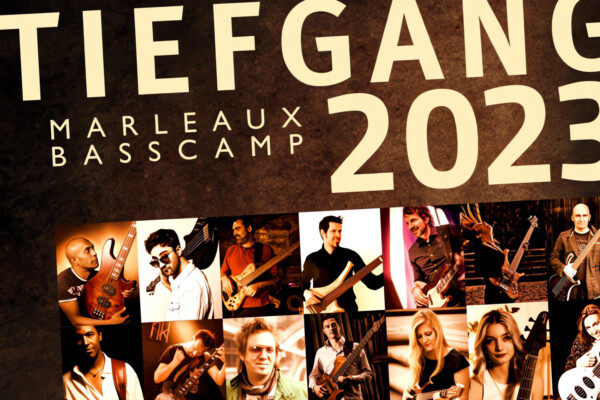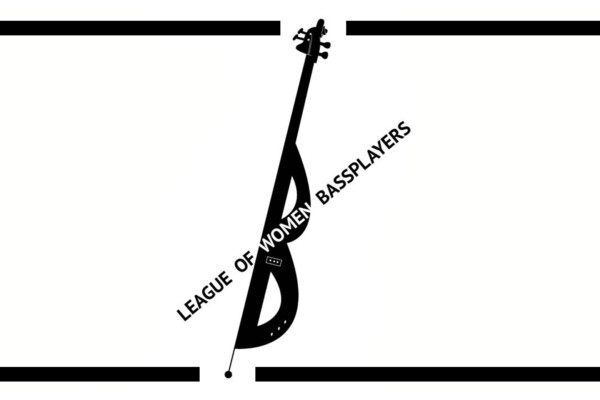Bass Transcription & Interview: Ariane Cap’s “El Soprano Diddle”

Ariane Cap uses a Marleaux Consat Soprano bass on this piece, and it is a very small bass. It’s essentially a mini-version of their Consat bass design but on a much (sorry about the pun) smaller scale. At a mere 22.4 inches, the scale length is remarkably short, but Marleaux has somehow managed to cram in 24 frets. The electronics on this instrument are super-simple – a single Delano Humbucker is controlled by a stacked volume/tone control.
Tell us about the Marleaux Consat Soprano bass – it looks amazing… but tiny.
Rumor has it that it’s a regular Consat shrunk in the wash, but Gerald Marleaux told me how he came up with the idea for the Soprano. The shape of Marleaux Consat basses is quite unique, so he used to make little Consat bodies and put a clock into them and gift them to the dealers and stores to hang on the wall as an advertisement for Marleaux.
One day he decided to see what would happen if he made an entire miniature bass from one of those “wall clocks”. This actually proved quite difficult because all the parts (tuners, pickups, bridge, nut, controls, etc.) needed to be specially created in mini sizes. Then the search began for the right string gauges and to find the sweet spot for the sound… But he prevailed and… voila, the Soprano was born and with it a super unique sound and playing experience.
Is it tuned the same way as a normal bass?
Ari: Yes, sopranos are tuned like a normal bass but an octave higher. They’re strung with the top four strings of a six-string bass set (The A, D, G, and C strings), but tuned E A D G.
How does this bass compare to playing the piece on a full-size Consat?
Ari: Wrapping my thumb around the neck, hitting the E on the 12th fret and the root of the chord with the open string while hitting the 6th and minor third on the top two strings is just smooth and easy to do on this instrument’s neck; and then you want to take the idea and put it on its big brother Consat and you’d need to find extra fingers!
What are the advantages of the soprano bass?
Ari: The coolest thing about those basses is that they make you come up with a lot of things you’d otherwise not think of because everything is much, much closer together. So, you end up having a huge range within one hand. And chords sound great, not muddy at all! It’s an amazing instrument that really stimulates the creativity. An added bonus is that it makes you look like a giant instantly.
What prompted you to compose ‘El Soprano Diddle’?
Ari: It’s been a few years since Wolf and I came up with this little piece. I had just gotten my Marleaux Soprano bass and was experimenting with it. The sound of these little gems is an octave up – quite unique, like a hybrid between a guitar and a bass. So being the bass players we are, at first, a bass line emerged. Wolf found a cool stylus RMX loop that had a bit of a Latin vibe.
Wolf: To me the charm of the piece lies in the melodic bass line and this is what started the idea. To use well-established materials like these chords and a root-five bass line idea and add little things, variations, double stops to make it stand on its own. Such are some of the most interesting bass lines to me – they serve the song (which in this case we could still flesh out), yet they have character, are recognizable on their own and even sound appealing when standing on their own with just a drum groove. The main chord progression is very straight forward and that is intentional; It’s a I-IV-II-V sequence in A minor – simple and effective. The B section shows a nice contrast rhythmically and is based on a linear, singable line.
Analysis
‘El Soprano Diddle’ is a short, Latin-inspired bass solo piece in A minor. There are some interesting technical aspects including double stops, full chords, and moving octave ideas.
The piece begins with a couple of bars of drum machine groove before Ari joins in with the bass line. The intro uses octaves of E and F, and then a run-down back to A. The main groove (letter A) starts with a simple root-fifth idea over an Am chord. This is followed by two bars of Dm using a similar idea, and then a turnaround that uses Bm7b5 and E7. This whole section is repeated (A2).
In the next section (B), the rhythms are more broken up than in the A sections and initially uses tenth double stops to imply a jazzy chord sequence. A rather tricky movement fingering-wise in bar 28 (the top note of the chord implies a flat 9, then the octave, then the sharp 9 over the E7 chord) is followed by a run-down which leads us back into the original groove at bar 30 (A3). This section ends in another rundown in bars 37-9 that recalls the introduction. The piece is finished with an interesting four-note voicing chord of Am6 (A E C F#) in bar 40.
The piece has a very pleasing feel, and the more complex technical ideas don’t disrupt the groove but add some interesting flavors to it.
Follow along with the transcription and video:



Wow, slick little bass. Thanks for sharing Ari.
You are most welcome! Glad you enjoyed. It’s a really fun instrument